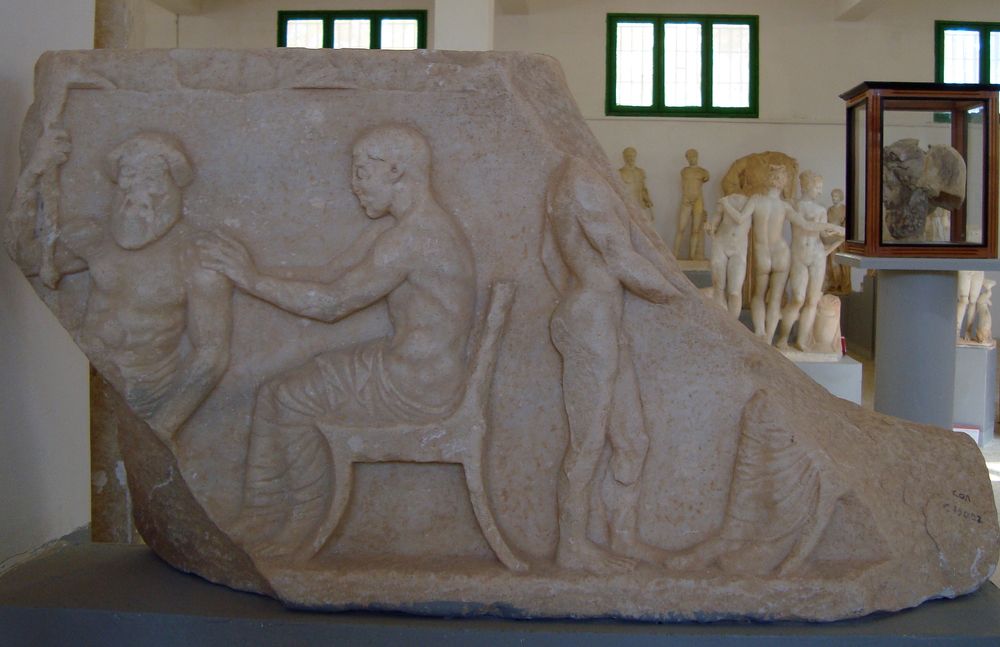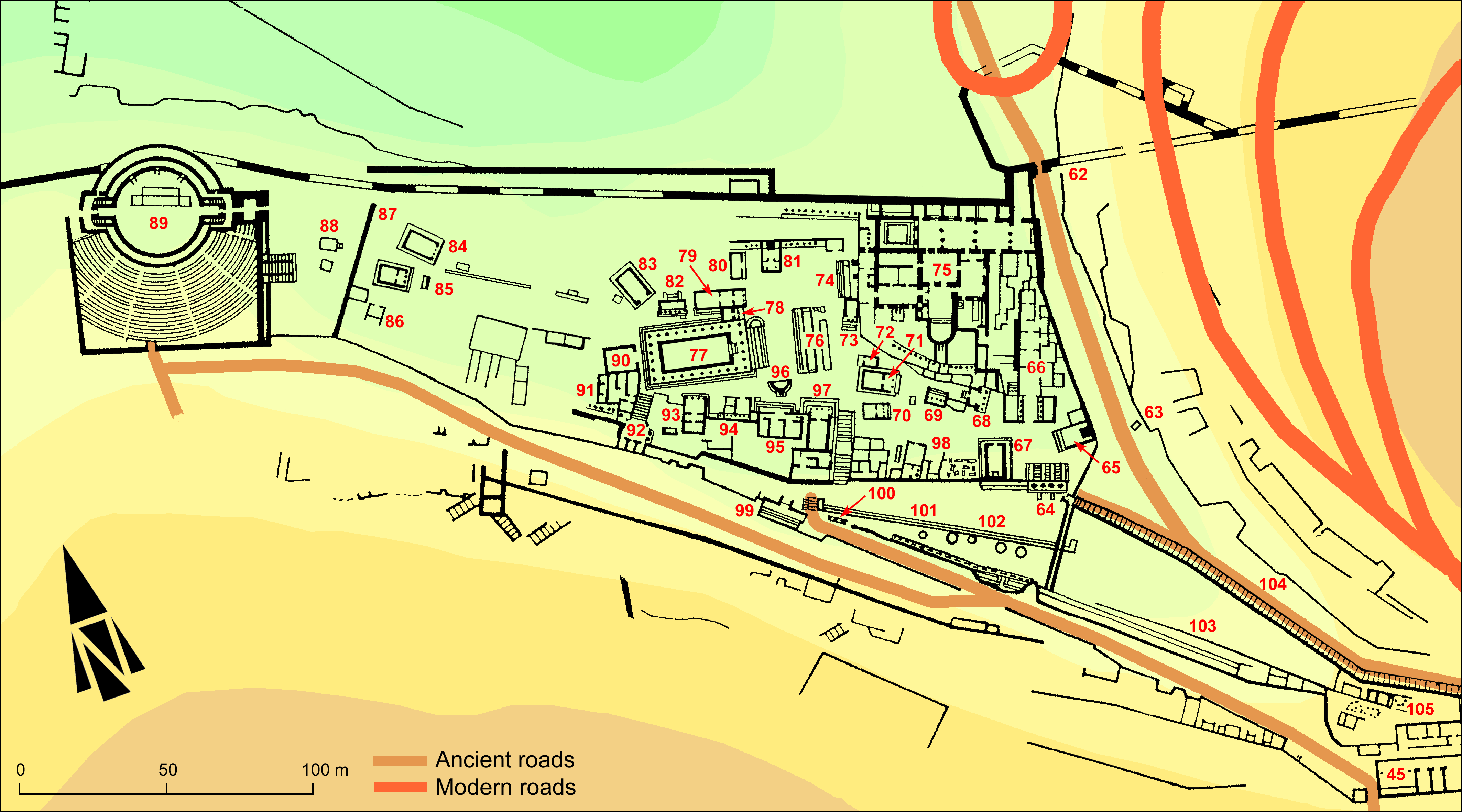EpiDoc XML:
GVCyr0272
Trismegistos ID:
738920
Source description
Support: Rectangular block of white marble sculpted on one side with a relief showing
a scene of healing, belonging originally to a frieze; re-cut and re-used on the opposite side which has a relief of a man
half-lying; his left elbow resting on a cushion, he holds a phiale on his left hand; his right arm rests on the couch at waist
level,
with two fingers falling down onto the plinth, as if it were the couch. Parts are missing at the upper left angle and on the
right edge
(w: 0.87 × h: 0.50 × d: 0.19).
Layout: Inscribed in two groups of three lines each on the plinth,
(w: 0.83 × h: 0.13); some lines do not begin at the left edge nor did they necessarily be cut on to the right edge.
Letters: L. 1 0.017; ll. 2-3 0.015; ll. 4-6 0.01, with serifs; pi with protruding upper bar, rho with small and nearly square loop,
tall and narrow sigma, phi with a very small and flattened loop.
Date: 2/3 AD (internal date).
Findspot: Found in 1925 at Cyrene ➚:
near the Fountain of Apollo.
Place of origin: Findspot.
Last recorded location: Cyrene Museum, 27.
Observed by J.M. Reynolds before 1963 in
Shahat: in the ancient
Sculpture Museum.
Observed by C. Dobias-Lalou in Shahat: in 1979 in the ancient
Sculpture Museum (with inventory number for sculpture 258) and again in 2010 in the new
Cyrene Museum.
Text constituted from: Transcription from stone (CDL).
Bibliography
Oliverio 1933-1936, p. 67, pl. XV, figs. 22 a and b, whence, SEG, 9.63; Reynolds 1963; Chamoux 1976; GVCyr 027 ➚.
Cf. Wilhelm 1938, pp. 71-72 whence Robert, BE, 1939.563; Robert 1940, Robert 1946, pp. 142-145; Lloyd-Jones 1964 whence Robert, BE, 1965.468; Peek 1972, n. 7; Dobias-Lalou 1998, p. 211; Dobias-Lalou 2018, pp. 192-194 and fig. 1, whence SEG 68.1745.
About the two reliefs, to the full bibliography of Chamoux 1976 add Micheli 1998.
Text
Interpretive
(ἔτους) λγ´ ἐπὶ ἱερέως Παυσανία Φιλίσκω φύσει δὲ (vac. 3) Εὐφάνευς
(vac. 6) παυσαμένων πάντων τῆς ἀνείας Λούκιος Ὄρβιος Λουκίου
(vac. 6) πυλοκλειστὴς τὸν λυσιπόλεμ̣ον (vac. 3?)
ἡνίκα Μαρμαρικοῦ λῆξεν πολέμοιο κυδοιμός, γήθησεν Βάττου πολλὰ πόλις μερόπων· τῆμος ἀν[α-]
5γλύψας κατακείμενον ἡδυπο{πο}τοῦντα Λεύκιος εἰνοδίωι θῆκε παρὰ προθύρωι
κλεῖ[δα] πύλης διέπων, Ὧραι φίλαι, οὗ χάλις ἔσχεν Παυσανίαν ἱερῆ καιρο[ῖ]ο παυσάμεν̣ον
Metrical
(ἔτους) λγ´ ἐπὶ ἱερέως Παυσανία Φιλίσκω φύσει δὲ (vac. 3) Εὐφάνευς
(vac. 6) παυσαμένων πάντων τῆς ἀνείας Λούκιος Ὄρβιος Λουκίου
(vac. 6) πυλοκλειστὴς τὸν λυσιπόλεμ̣ον (vac. 3?)
| ἡνίκα Μαρμαρικοῦ λῆξεν πολέμοιο κυδοιμός,
γήθησεν Βάττου πολλὰ πόλις μερόπων·
τῆμος ἀν[α-]|(5)γλύψας κατακείμενον ἡδυπο{πο}τοῦντα
Λεύκιος εἰνοδίωι θῆκε παρὰ προθύρωι
5 | κλεῖ[δα] πύλης διέπων, Ὧραι φίλαι, οὗ χάλις ἔσχεν
Παυσανίαν ἱερῆ καιρο[ῖ]ο παυσάμεν̣ον
Diplomatic
𐅹 ΛΓ ΕΠΙΙΕΡΕΩΣΠΑΥΣΑΝΙΑΦΙΛΙΣΚΩΦΥΣΕΙΔΕ ΕΥΦΑΝΕΥΣ
ΠΑΥΣΑΜΕΝΩΝΠΑΝΤΩΝΤΗΣΑΝΕΙΑΣΛΟΥΚΙΟΣΟΡΒΙΟΣΛΟΥΚΙΟΥ
ΠΥΛΟΚΛΕΙΣΤΗΣΤΟΝΛΥΣΙΠΟΛΕ.ΟΝ
ΗΝΙΚΑΜΑΡΜΑΡΙΚΟΥΛΗΞΕΝΠΟΛΕΜΟΙΟΚΥΔΟΙΜΟΣΓΗΘΗΣΕΝΒΑΤΤΟΥΠΟΛΛΑΠΟΛΙΣΜΕΡΟΠΩΝΤΗΜΟΣΑΝ[.-]
5ΓΛΥΨΑΣΚΑΤΑΚΕΙΜΕΝΟΝΗΔΥΠΟΠΟΤΟΥΝΤΑΛΕΥΚΙΟΣΕΙΝΟΔΙΩΙΘΗΚΕΠΑΡΑΠΡΟΘΥΡΩΙ
ΚΛΕΙ[..]ΠΥΛΗΣΔΙΕΠΩΝΩΡΑΙΦΙΛΑΙΟΥΧΑΛΙΣΕΣΧΕΝΠΑΥΣΑΝΙΑΝΙΕΡΗΚΑΙΡΟ[.]ΟΠΑΥΣΑΜΕ.ΟΝ
French translation
Translation source: Chamoux 1976
An 30. Sous le prêtre Pausanias fils de Philiskos, mais par le sang fils d'Euphanès, quand tous furent délivrés de leurs soucis,
Loukios Orbios fils de Loukios, portier, [a consacré l'image] de celui qui a mis fin à la guerre.
Quand eut cessé le tulmulte de la guerre marmarique,
le peuple de la cité de Battos se réjouit grandement.
Alors, l'ayant fait sculpter allongé, se régalant de vin,
Loukios, chargé de la clef de la porte, plaça près du porche donnant sur la rue,
aimables Heures, là où le vin pur s'est emparé de lui,
le prêtre Pausanias qui a mis fin au temps de guerre.
English translation
Year 30. Under priest Pausanias son of Philiskos, natural son of Euphanes, when all were freed of trouble, Loukios Orbios,
son of Loukios, a doorkeeper, [dedicated the image] of the man who brought the war to an end.
When the uproar of the Marmaric war had ceased,
the people of Battos' city rejoiced a lot.
Then, having let him sculpted lying, pleasantly drinking,
Loukios, who was in charge of the door key, placed near the porch opening on the street,
friendly Horai, at the place where undiluted wine took hold of him,
priest Pausanias who brought to an end the war time.
Italian translation
Anno 30. Sotto il sacerdote Pausanias figlio di Philiskos, figlio naturale di Euphanes, quando tutti furono liberati dall'affanno,
Loukios Orbios, figlio di Loukios, portiere, [ha dedicato l'immagine] dell'uomo che ha posto fine alla guerra.
Quando il tumulto della guerra marmarica cessò,
il popolo della città di Battos gioì assai.
Allora, fattolo scolpire sdraiato, intento piacevolmente a bere,
Loukios, incaricato della chiave della porta, presso il portico che dà sulla strada
pose, o amabili Ore, là dove vino schietto si impossessò di lui,
il sacerdote Pausanias che pose fine al tempo della guerra.




